21.5-inch iMac (Late 2013) Review: Iris Pro Driving an Accurate Display
by Anand Lal Shimpi on October 7, 2013 3:28 AM ESTWiFi & IO
The new iMacs join the 2013 MacBook Airs in supporting 802.11ac. Unlike the MBA implementation however, the iMac features a 3 antenna/3 stream configuration with the potential for even higher performance. Connected to Apple’s new 802.11ac Airport Extreme I was able to negotiate the maximum link rate of 1300Mbps. I will say that maintaining the full speed connection was quite tricky and required very close proximity to the AP, and that the AP was located physically higher than the iMac.

Range was absolutely incredible on the Airport Extreme/2013 iMac combination. I didn’t have time to map out speed vs. distance from AP before leaving on my most recent trip, but I will say that the combination of the two gave me better WiFi range/performance than any other wireless device I’ve ever tested. I need to spend some more time with the two but color me completely impressed at this point.
With OS X 10.8.5 Apple addressed some of the performance issues that plagued real world use of 802.11ac. Prior to the 10.8.5 update,I could get great performance using iPerf, but actually copying files between Macs on the same network never substantially exceeded the performance I could get over 802.11n.
The 10.8.5 update somewhat addressed the problem, raising average performance copying over an AFP share to ~330Mbps. It’s not unusual for software companies to only partially address an issue in existing software, especially if there’s an actual fix coming just around the corner. I had a suspicion that’s what was going on here so I threw OS X 10.9 (Mavericks) on both the iMac and my source machine, a 13-inch MacBook Pro with Retina Display.
The 13-inch rMBP was connected over Thunderbolt/GigE, while the iMac was connected over 802.11ac to the same network. First, let’s look at UDP and TCP performance using iPerf:
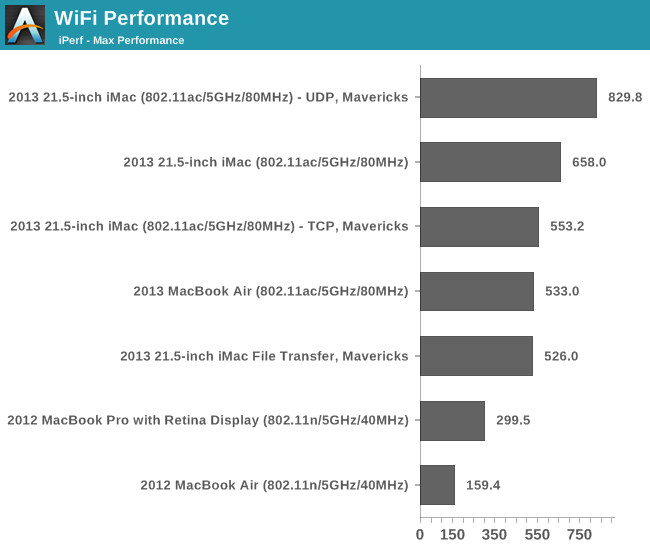
Peak UDP performance is 829.8Mbps. Running the same test using TCP drops performance down to 553Mbps. What about actual file copy performance? I saw peak performance as high as 720Mbps, but average file copy speed over my network setup was ~500Mbps.

You can definitely get better transfer speeds over wired Gigabit Ethernet, but 802.11ac (particularly over short distances) is very good. You’ll need to wait for Mavericks to really enjoy this performance, but the wait is almost over.
The rest of the IO is the same as in last year's model. You get four USB 3.0 ports, two Thunderbolt 1.0 ports, GigE, SD card reader, and a 1/8" jack:
The Chassis
Last year Apple redesigned the iMac, making it thinner at the edges than an iPhone 5/5s or even an iPad mini. Many pointed out that reducing edge thickness didn’t really matter all that much given the center of the iMac bulges out quite a bit. Given that there’s no internal battery you need more space for, reducing chassis volume is purely an exercise in design with no real tradeoffs as long as you can adequately cool what’s inside. I can’t speak to the 21.5-inch iMacs with discrete graphics, but the 65W Haswell + Crystalwell model I was sampled exhibited no thermal issues during even heavy use.
The iMac’s lone internal fan hummed along at ~1400 RPM during light use as well as during repeated Cinebench R15 runs while writing this review. One positive side effect of Intel targeting notebooks for all of its microprocessor architectures is the ease of cooling these 65W “desktop” parts. Keep in mind that Apple delivers a similar amount of performance in a very thin 15-inch notebook chassis as it does in a 21.5-inch iMac chassis.
Despite the reduction in internal volume, the redesigned 27-inch iMac is still a bit bulky to move around. The same can’t be said for the 21.5-inch model however. Weighing only 12 pounds (the equivalent of a small dog or large cat), the 21.5-inch iMac is almost portable. I had to carry it around a lot during the course of my review (between desks, photo area, and in testing WiFi) and I quickly appreciated just how compact this system is. Particularly in its default configuration, there’s only a single cable you have to deal with: the carefully angled power cable going into the machine.
It’s also neat to look at the iMac compared to one of my 24-inch CPU testbed monitors from a few years ago and realize that the two have virtually the same resolution, and the iMac is not only a better display but comes with an integrated Haswell PC as well.


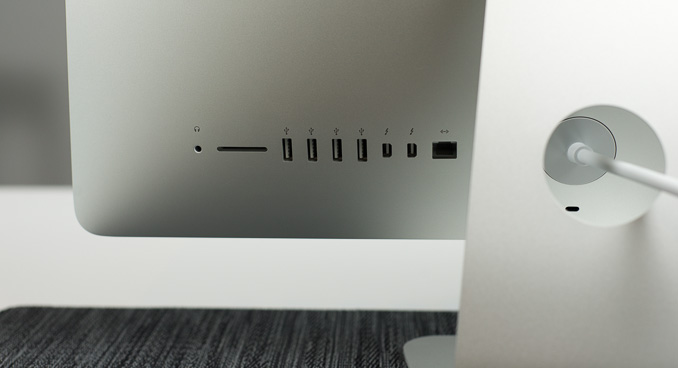
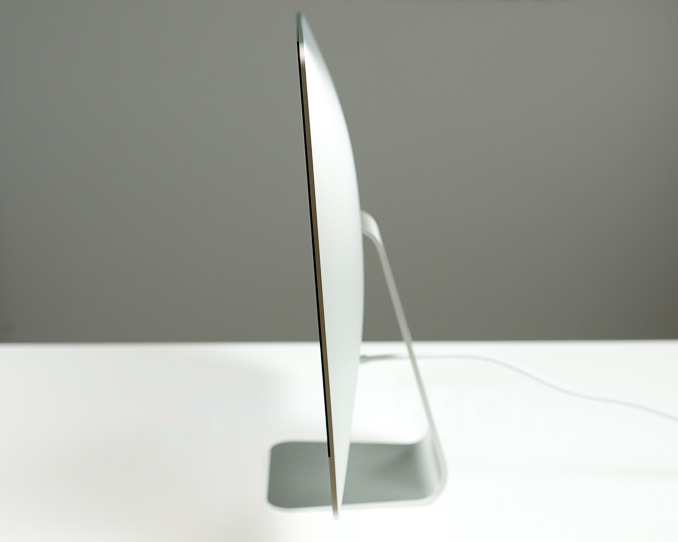
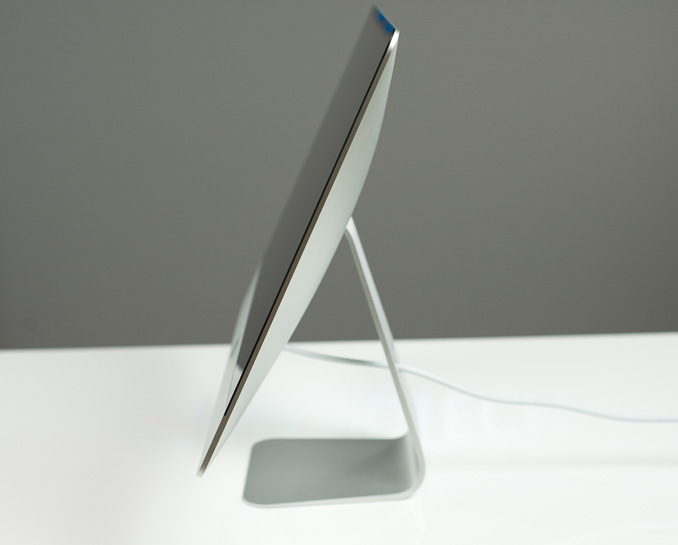
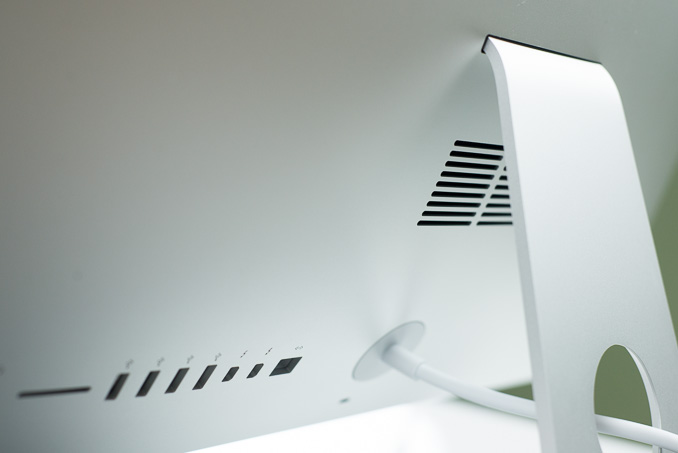








127 Comments
View All Comments
foolio5 - Monday, October 14, 2013 - link
Sammy 840 EVO 128 GB SSD is $99 bucks and up there in the speed/longevity department.akdj - Tuesday, October 15, 2013 - link
Sammy 840 will read about half the speed of the new PCIe SSD in the 2013 iMac. It'll be at least twice as quick. These aren't 2.5" SATA3 drives. They're PCIe. Big difference. Small price to pay for the upgrade. You'll never know you don't have a 1.15 TB SSD in there for most consumer workflows. They. Flat. Fly. It's a bargain. That said, I'm with you on the RAM. $100 for 16 seems fair and nicely set for three-five years. While still being able to sell it for 50% after a half decade :-)djscrew - Monday, October 7, 2013 - link
putting a hard drive in, even at a base level, should be considered a crime to computing in this day and age... a 256 gb ssd should be stock... for a company that pushes quality and doesn't concern itself as much with price, apple should have ditched the hdd this generationsaarek - Tuesday, October 8, 2013 - link
256GB is not enough memory for a large proportion of computer users, a more realistic and useful answer would have been for Apple to have made the 1TB Fusion drive the default option.iwod - Monday, October 7, 2013 - link
I Hope Apple can cut cost in their next model some where and put in SSD as Default.idget - Tuesday, October 8, 2013 - link
Personally I prefer the design of the '09 models. Sure it doesn't look "pretty" as these ones (subjective), but I feel that on the imacs, Apple's "thin is good" mentality is annoying.The "bulge" at the back looks ugly. Also because it's so thin, everything is moved to the back, including the sd card slot, which I feel is better on the side of the computer. It's a pain having to reach around the computer (especially on the 27inch). Also it needs more usb ports
I feel that Apple has gone for looks and forgot function on these imacs
alpha754293 - Tuesday, October 8, 2013 - link
How much power does it consume at full load and at idle?MF2013 - Tuesday, October 8, 2013 - link
I'm not sure if the graphics comparison to the DDR3 version of the GT 750m is fair. The DDR3 cripples the graphics performance, and while I don't know what the sales volume numbers are, my impression is that most 750m's that ship do so with DDR5. Also, anybody who games and cares about GPU performance, and is the least bit informed, would make sure to get the DDR5 version. And it's not like the DDR5 version is expensive- the Lenovo y500's that occasionally go for sale around $830 have 2GB of DDR5.So all this demonstrates is that Iris Pro graphics can compete with bandwidth crippled discrete graphics. But if you don't care about gaming, you shouldn't care about whether the integrated graphics are competitive with discrete GPUs. And if you do care about gaming, this performance is still not good enough. The positive tone of this review doesn't seem justified.
speculatrix - Tuesday, October 8, 2013 - link
I just hope you never have to have it repaired out of warranty.mschira - Tuesday, October 8, 2013 - link
nice review, and interesting to see that with Crystallwell there is an integrated GPU that does have acceptable performance.Will be interesting to see in a 13" MBR.
What would also be interesting are performance comparisons of the new real GPUs if and how much better they are than the 2012 level.
GPU performance is still a bottleneck for iMacs I think (i.e. gaming).
M.